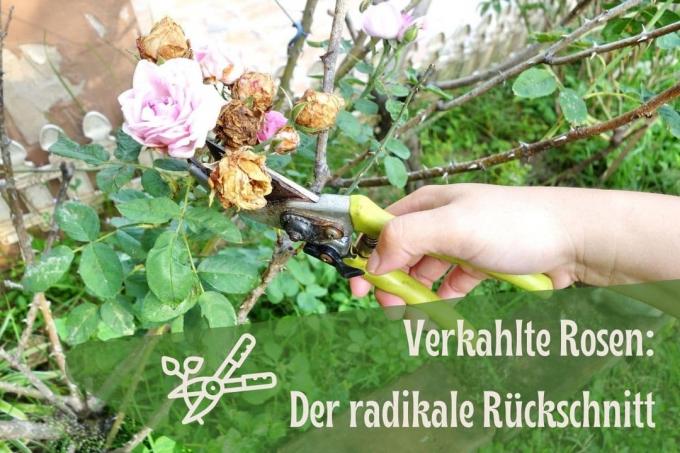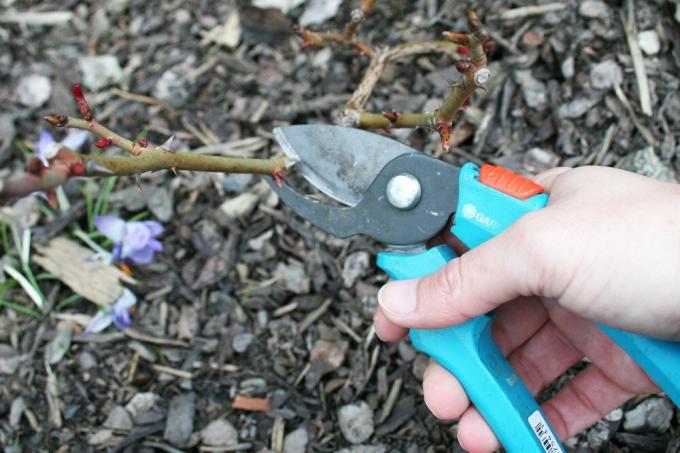
table of contents
- time
- Utils
- Cut back the bald roses
- Cut back the ground cover
- Cut back climbing roses
- frequently asked Questions
Bald roses are not a pretty sight. The number of flowers steadily decreases while the shoots become longer and weaker. Radical pruning is necessary to save the plants.
In a nutshell
- The time to cut the roses is a frost-free, dry day in mid-February with extensive cloud cover
- the tool used should be disinfected and sharp
- the pruning is carried out depending on the corresponding rose class
time
Bald roses need intensive pruning so that they can shine again in the garden. It is important to have the right time for the rose pruning, which contributes a lot to the vitality of the plants. If, for example, you cut in autumn, the weakened plants are unnecessarily exposed to the harsh winter cold, which they do not always survive. At the same time, you must observe the point in time depending on Section 39 (General protection of wild animals and plants) of the Federal Nature Conservation Act (BNatSchG). In the fifth section it is specified that trees such as pink may only be cut back radically over the following period: 30. September to 1. March. Depending on these regulations, the following pruning time has been established for bald roses:

- Mid to late February
- Frost free
- no sun exposure
- dry
Note: You can also use the forsythia (Forsythia intermedia) flower as a guide when it comes to timing. This shows when radical pruning is recommended for bald roses.
Utils
One of the most important points when cutting a rose is the utensils you choose. Bald roses should only be cut with suitable tools to prevent sores from forming. The following list goes into this including the other cutting utensils:
- Bypass scissors
- Pruning shears or pruning saw (ideally with Japanese teeth)
- long work or gardening gloves (spike-proof)
- Ladder (for climbing roses)
- solid clothing
- safety goggles
Make sure to use high quality tools. This allows you to easily cut larger roses without the scissors or saw failing. If your roses are bald, you can expect them to develop numerous, robust spines. These can lead to a wide variety of injuries if you do not wear suitable protective clothing. Depending on the shape of the rose, you may even have to reach into the bush, which should never be done without gloves, a long-sleeved top and protective goggles.
Tip: It is essential to disinfect and sharpen the tool before use so that no bacteria, viruses or fungi can get into the wound sites.

Cut back the bald roses
Numerous types of roses that need a radical rejuvenation cut present themselves bare and without lush blossoms. Compared to the other rose classes, the instructions presented in this section are suitable for several. This includes:
- Precious roses
- Shrub roses
- Small shrub roses
- Flower bed roses
- Wild roses
They are all cut in the same way:
- work from the outside in
- never remove green shoots
- Balded wood is brown and dry
- Remove bald shoots and twigs
- Use a saw or scissors depending on the branch thickness
- Cut directly above the finishing point
While you are completely removing the bare branches and twigs, cut the rest back to a length of 25 to 40 centimeters. Always cut a short distance above a bud or an eye that is facing outwards. This way, the entire rose can be trimmed radically. You also ensure that you do not remove any fresh shoots. Only with this can the pinks take on their original shape before they are bald. Likewise, you must not cut directly into the processing point, as this can permanently damage the plants. At the end, don't forget to remove any conspicuous wild shoots that grow out of the ground below the shrub base. They do not bear flowers and use up the plant's energy reserves.

Cut back the ground cover
Bald roses are not uncommon even with the compact ground cover species. The radical cut is the quickest for the dwarves and can be carried out without any problems. From the outside in, cut off any branches and shoots that you can see on the plant. Depending on their size, they are cut in half, for which the bypass scissors are ideal. You don't need to be precise with the ground cover.
Note: Cut back bald dwarf roses in the same way. The varieties then sprout much more densely, which has a positive effect on the look and abundance of flowers in the coming season.
Cut back climbing roses
Are your Climbing roses bald, you have quite a bit of work to do. The mass of clippings alone, which, for example, Rambler roses form over the years, require extensive pruning measures. Especially with the species within this class you should not forget to wear protective clothing, as they grow very densely and individual shoots cannot always be reached easily. You should also not forget your ladder to get to the difficult parts of the climbing rose. The following instructions introduce you to the pruning:
- Detach branches and shoots from the climbing aid
- appraise
- Remove dead wood
- Cutting height: 10 to 50 cm above the ground

Here, too, you should leave the young shoots standing. They enable the rose to sprout quickly. Do not be surprised. Climbing roses do not bloom until the second year after cutting. So you have to be patient a little longer.
frequently asked Questions
If a rose becomes bald, it can carry viruses, bacteria and fungi. Even pests are not uncommon. For this reason, you should never dispose of the clippings on the compost, as this increases the risk of infesting other plants in your garden. Ideally, it is disposed of with the residual waste or given to the recycling center as green waste. The leftovers are free of charge up to a certain amount.
The roses can easily be shaped after the cut. Since they are no longer bald, they can be trained according to the desired shape. The new shoots can be shaped much more easily than the bare branches. The shaping of climbing roses is particularly effective after radical pruning.
No, there are some species that do not need an annual pruning and should only be thinned out a little as a check. These include only the native wild roses, for example the potato rose (Rosa rugosa), vinegar rose (Rosa gallica) or dog rose (Rosa canina). Due to their robust nature, they do not bald so quickly, which means that you do not have to reach for scissors as often.
